Family : Equidae

Text © DrSc Giuliano Russini – Biologist Zoologist

English translation by Mario Beltramini
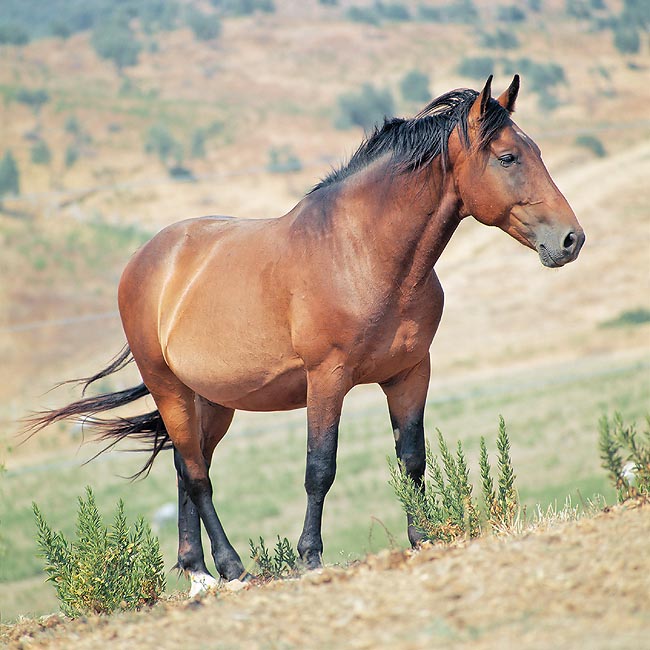
A Maremmano: strong build, mild character and a feeling of exceptional power © Giuseppe Mazza
Eutherian quadruped mammal, infra- class Placentals (Placentalia), order Perissodactyls (Perissodactyla), family Equids (Equidae), genus Equus.
The Horse (Equus caballus Linnaeus, 1758) is a mammal living in close relation with the man (like the cattle, the sheep and goats and the pigs) since the Bronze Age (from 3.500 BC to about the 1.200 BC), when, for the first time it was tamed by the populations of central Asia and by these utilized for the meat, the milk, the skins, the work and as means for moving more quickly. Its origins, however, date back to more ancient times.
The first perissodactyls appear in the early Eocene in northern America and in Europe, through a continuous evolution line originating in the Pleistocene, Quaternary Period, the genus Equus, to which belongs the present horse.
The phylogenetic development of the equines is of the maximum scientific importance for the biologists, as, thanks to the abundance of the fossil findings, it is possible to piece together the main evolutive lines which have led to the presently extant specimens.
In Zoology, the gradual morphological changes can be summarized into key trends, as it was proposed by the English biologist Herbert Spencer (1820-1903) :
1- Progressive increase in stature.
2- Passage from the life in woody zones to the open ones, like steppes and prairies. In the same time, we notice a transformation of the skeleton, due to the adaptation of the prolonged running on solid soil. Most of the body weight, at a certain point of the evolution development, starts burdening on the third toe; for this reason the number of the toes lessens from four to three, for then later on becoming one only, which will be wrapped by a big ungula forming the hoof. It’s for this reason that the perissodactyls and consequently the horses are defined “mesaxonic” by the zoologist biologists.
3- Due to the change of the environmental conditions, we observe an evolution of the teeth, symptomatic of an answer guaranteed by the phenotypic plasticity of the species to the ecologic modifications. The teeth cover gradually with cementum, the molars tend to look like the premolars, the cusps of the molars unite in crests and the crown becomes bigger.
In northern America, they have found fossil skeletons of four specimens and several fragments of the first equid known to the Biology, the Eohippus, which can be located in the lower Eocene, Cenozoic Era. This quadruped was of a very small size. Big almost like a rabbit, it had an about 13 cm long skull, and the height at the shoulder was not exceeding the 25 cm.
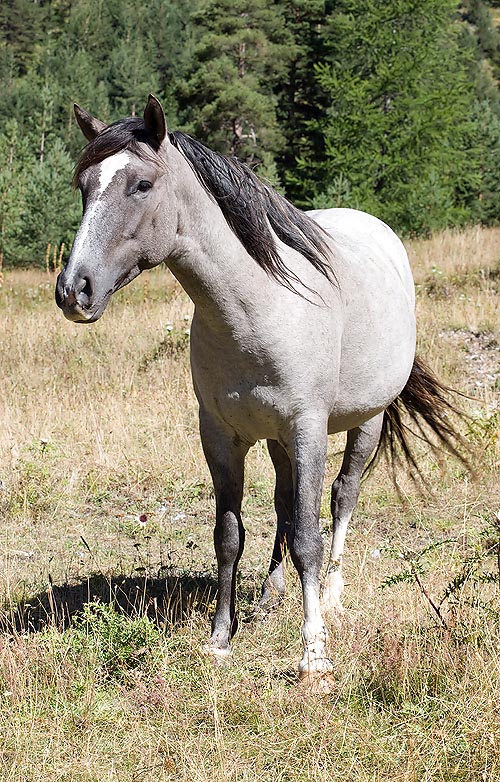
Argentine Horse © Giuseppe Mazza
The forelimbs were equipped with four toes, whilst the hind limbs were tridactylous, with rudiments of the first and fifth ones under form of small bony buttons protruding backwards.
Also the teeth had characters extremely primitive: the molars with low crown had four to six distinct cusps, at times united in a hint of transversal crests. The Eohippus lived in the woods.
The following step in the evolution process is marked by the appearance of the Orohippus in the middle Eocene. The bone structure increases in size, passing from a height at the withers of 25 cm to 38, whilst the toes of the forelimbs reduce from four to three.
Passing to the late Eocene, we find the Aminhippus and the Epihippus, and we reach, finally, the Mesohippus in the early Oligocene.
It seems that the last one marks the passage from the life in the woody zones to that in the prairies and the steppes, with consequent and ulterior modification of the limbs. The body gets the size of a big dog, the feet, now tridactylous, show a gradual hardening of the central toe, the crests of the molars tend to become more complicate.
In the late Oligocene appears the Miohippus, bigger and with a longer muzzle than its progenitor, the Mesohippus. In the genus Parahippus, of the Miocene, there is the beginning of the “hypsodonty”, which is the development of the dental crown. This led, in the middle Miocene, to the appearance of the Merychippus, which is now a real and true horse. It measures 120 cm at the withers, the lateral toes do not touch any more the ground and, consequently to the new type of alimentation of the prairie, the molars get their final structure.
From the Merychippus come the Hipparion and the Neohipparion, which around the end of the Miocene, migrate, through the “Bering Strait”, in the Eurasian continent, where they develop enormously, becoming, in number, the most representative animals. The Hipparion has still the feet tridactylous and is as big as the cub of a zebra. From central Asia, owing to climatic variations which render the living conditions prohibitive, these horses move westwards, reaching Europe and Africa.
Many of them go back to northern America, and, through the Isthmus of Panama, they descend to southern America, where they have found remains of equines with a singular cranial conformation.
In the Pliocene the evolutive line of the horses of North America continues with the Pliohippus, in which the lateral toes have almost completely regressed. This leads to the genus Equus, last stage in the phylogeny of the horse, which in the Pleistocene spreads in the two Americas and, thanks to several migrations, in the other continents.
Nevertheless, still in prehistoric times, the equids extinguish and disappear completely from the two Americas. They will be reintroduced in these territories, by the Europeans, only after their discovery by Christopher Columbus. In Europe, a collateral line of the equids evolves since the lower Eocene, starting with the primitive genus Hyracoterium, similar to the Eohippus. However, this is known less than that originated in the American continent.
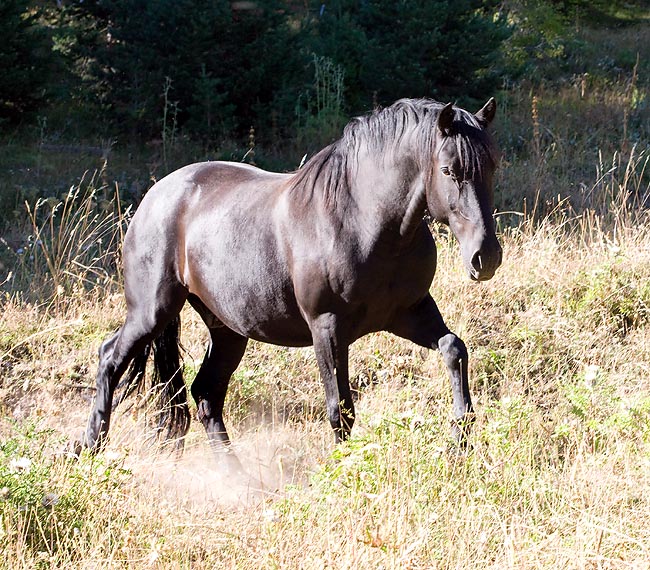
Mérens Horse © Giuseppe Mazza
In the middle Oligocene, The European horses do extinguish. Only remain the fossils datable to the late Eocene, of the Paleotherium magnum, whose di- mensions were about those of a tapir. In the Miocene, the North American Miohippus migrates through the Bering Strait and populates again the European continent. Also this genus extinguishes, before the arrival of the great flocks of Hipparion. The evolution of the equids can be quantified in a long period of about 50 million of years, following a main line which leads to the present horses, from which collateral branches, nowadays extinct, had developed. Among the various species of horses which lived during the glacial period, there were two particularly important ones, because they are the progenitors of the present tamed races.
The Tarpan (Equus gmelini), which populated the Eurasian steppes and has extinguished in 1700, and the Prze- walski’s Horse (Equus przewalski), living in central Asia, between Siberia and western China, and is the only species still found in the wild. We shall treat of this species later on, about its geographic distribution.
Morphophysiological characteristics
The horse has a slender body, remarkable stature (the height at the withers varies from 1 to 1,75 m), agile and solid legs, long and robust neck, furnished with mane, in the male as well as in the female. The head is elongated and triangular. Two lively big eyes stand out; the nostrils are wide and mobile, like the ears. The teeth correspond to the formula: 3/3, 1/1, 3/3, 3/3 = 40 teeth. The fractions represent the same type of tooth (usually, in the herbivores the canines are absent but are present in the horses, and more or less developed the incisors, whilst the premolars and the molars are the best developed and most numerous types) in the two, upper and lower, half jaws. The above formula is to be interpreted as follows: 3/3, 1/1, 3/3, 3/3. If we assume as a reference the upper mandibular arch (same thing may be done starting from the lower one), we get 3/3 = 6 incisors; 1/1 = 2 total canines; 3/3 = 6 total premolars; 3/3 = 6 total molars, therefore, by summing, we get 6+2+6+6 = 20 teeth in the upper mandibular arch (or lower, if we have started from that one). The total number of teeth present in the two mandibular arches (upper-lower) is obtained by multiplying 20×2 = 40 teeth in total.
The teething of the equids has some particular characteristics: the teeth are lined long protruding lines. The male have four rudimental canines, of conical shape, which are normally missing in the females. Between canines and former molars there is an empty space, called the “diastem”, in which the bit is placed. The incisors form, on each jaw, a cutting arc.
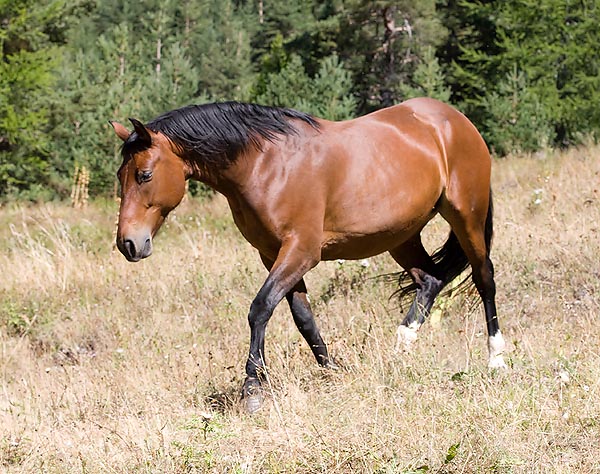
French Trotter © Giuseppe Mazza
They have different names: the two central are called “central incisors”, then moving laterally, we find the “middle incisors” and finally, the “corner incisors”. Both molars and canines have a continuous growth and are subject to constant wear. As the animal grows up, the crown wears out consuming the cementum which is contained, whilst the root goes on in growing.
The residue of the cementum permits to establish, quite accurately, the age of the hors till the eight years, age when the cementum disappears completely. For such reason, the breeders, as it is seen often in the movies, when buying a horse, look the mouth and the teeth, for the first thing, in order to ascertain the age and the health condition.
The skeleton of the leg has a reduction in the anterior as well as the posterior limbs, of the number of the toes. As said before, the body rests only on the third toe, much developed, whose last phalanx is incorporated in the hoof. The second and fourth fingers are reduced to small rudiments, called “styliform bones”, whilst only traces remain of the first and fifth fingers.
The humerus and the femur are not visible from outside, therefore those which seem to be the articulations of the elbow and the knee are actually the wrist and the heel, followed by the “metacarpal bones” of the third toe. The hoof is externally surrounded by a robust wall, which includes the sole. Behind, the sole bends inward and forms the “fork”.
The digestive system in relation with the alimentation of herbivorous type, as briefly said before, has a great development of the salivary glands and of the intestine, which is characterized by a voluminous “cecum”. Also the cerebral hemispheres are developed, sign that this animal has reached, evolutionarily, a remarkable level of intelligence. The senses of smell, touch and hearing are very much acute.
The coat is formed by short and shiny hair, which may be uniform or with several colours. In the first case, its can be black, white, sorrel (fawn with various tones). In the second case, that is when several colours do mix, the coat may be gray (mixed white and black hair), overo (white and reddish mixed hair), and roan (white, black and reddish hair). Furthermore, three are the coats with juxtaposed hair: bay (fawn mantle with black mane and tail), buckskin (cream-coffee coat, with black mane and tail) and piebald (with white spots on whatever background). Sometimes, spots and shades also in the uniform colours may happen, or even, wider spots mainly on the head.
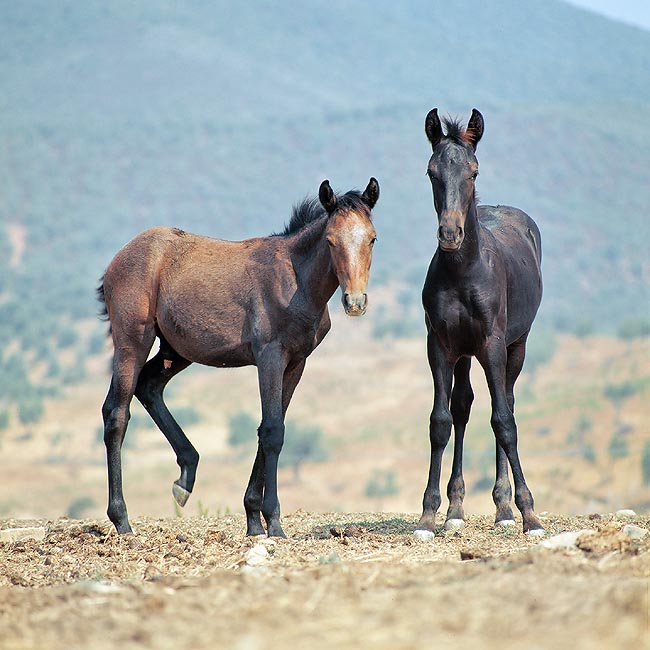
Foals of Maremmano Hors © Giuseppe Mazza
Biologic reproductive cycle
The biologic or reproductive cycle is initially characterized by the achieving of the sexual maturity, happening by the 18th month in the male and by the 22nd month in the mare. However, the coupling gives better fruits if it happens in a more advanced age.
The mating period coincides with the spring and the summer, even if the male can fertilize in any month. On the other hand, the mare is not always prone to the coupling.
The oestrum of the mare is perceived by the male which gets excited, even very far away, due to the emission of vaginal hormones-pheromones.
The entering in oestrus of the male brings this one to a strong state of excitement and agitation, with conti- nuous emission of whinnies and the clas- sical flehmen response, with consequent curling of the upper lip and exposition of the teeth.
This odd and showy sexual response of the excited stallion and its capacity to perceive a mare in oestrum also 2-3 km far away, was, historically speaking, utilized by the English and Prussian soldiers during the Seven Years War (1756-1763), for discovering, during the night, possible attempts to approach their camps by enemy battalions, formed by the alliance between French, Austrians, Russians, Poles and Swedes. For such purpose, they used to place mares in oestrum in the periphery of the camp. The possible arrival of the enemy cavalry belonging to the adverse coalition would have been immediately revealed, already at 2-3 km of distance, by the abundant whinnies of the male horses mounted by the enemies, due to the presence of the mares in heat.
The gestation lasts an average of 330-365 days, and usually produces one only son (single deliveries), twins can be generated rarely. For this reason, seen the length of the gestation, the females do not deliver every year. Upon its birth, the cub weighs between the 40 and 60 kg, and is nursed for 6-9 months. The cubs less than a year old are called foals. In the farms, they have the habit to wean them with a mix of crushed grass and oats, for then, later on, pass to hay with the oats in grain. The maximum development is reached at the age of five years, when they can reach weights, depending on the species and the races, from 500 to 900 kg. The lifespan of a horse in good health varies from 25 to 30 years. It is possible to cross the various species of the genus Equus, getting either fertile or sterile products.
Ecology and geographic distribution
For treating about the Ecology and the geogra- phic distribution of horses, we cannot do without considering the relationship of these animals with the humans. This dates back to the most ancient times. The graffiti found in some rock of France and Spain, show these animals and attest how the men of the Stone Age were hunting them.
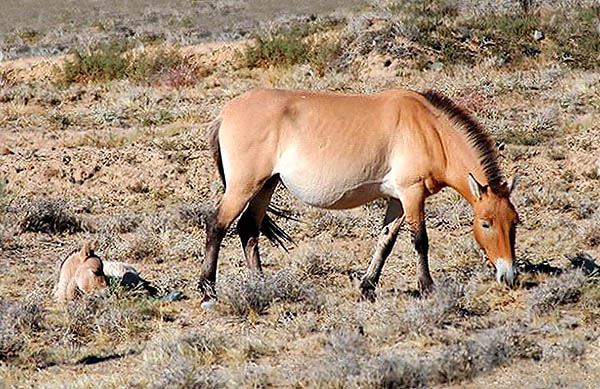
Equus przewalski with cub © David Blank
After some zoologist biologists, ethnobiologists and archaeologists, the Thracians, who were populating some Asiatic and European regions during the Bronze Age, were the first capable to tame the horse. It was the already treated Tarpan (Equus gmelini), an equid of medium size, with a grey coat, living in the steppe and in the woody areas and which extinguished, as said before, in the 1700.
From this moment on, man and horse engage together in the path of history. For centuries, the horse has facilitated the conquest operations to the expanding populations.
In the thirteenth century a new sport comes to life in England: the horse race, which remains exclusive of this country till the nineteenth century, allowing in this way the breeding and the selection of a race, highly specialized for this purpose. The Spaniards, by the mid of the XVIth century, compelled to retreat in haste, abandoned many horses in South America, where the genus Equus had completely extinguished. This initial nucleus originated the “cimarones” or “mustangs”, which, in about two hundred years, did populate the American prairies.
Nowadays, the descendants of the original Hispanic group, returned to the wild “feral species” have been almost completely exterminated; there is still, nevertheless, some rare flock living in the wild. Also the Przewalski’s Horse (Equus przewalski), considered by this time the only one extant wild species of the genus Equus, has quickly decreased in number during the last century. One of the reasons might be the facts that, during the summer months, the shepherds of the Asiatic steppe settle by the water sources, hindering these horses, as well as other ungulates, to approach the same. In this way a real competition for the water takes form creating irreparable damages to the most fragile and under risk of extinction species. From 1958 to 1963, they have sighted only scanty flocks of these horses, led by an old stallion and composed by 6 to 8 animals.
Anyhow, some specimens of these horses are present in the zoological gardens, zoo-safaris, zoo-parks where they reproduce quite easily, so that the biologists hope that, in not so long time, they may return to repopulate the Eurasian steppes.
The Equus przewalski owes its name to the Russian cavalry captain Nikolay Michailovich Przewalski, who, in 1879, found it during an expedition in central Asia, in Dzungaria and informed about this the Russian biologist Poyakov who made a scientific report about the matter.
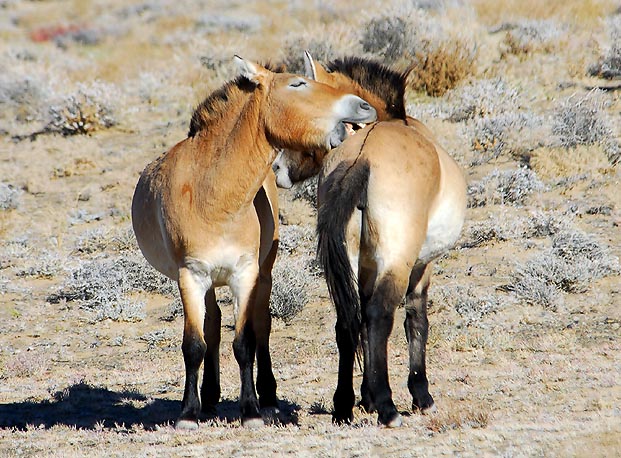
Tenderness between Equus przewalski © David Blank
For long, the Russian biologists of the St. Petersburg Academy of Sciences, after having received this report, discussed if it was or not the case to consider it as a new species, seen the not imposing structure and the little noble look, which were resembling it more to an ass than a horse.
Finally, the Russian biologists reached the conclusion to consider it as the only wild horse still living in the wild.
Its morphologic characteristics are: rather big head, short and stubby neck with a short and straight mane. The muzzle is white, the back is crossed by a dark line and the coat is reddish brown in summer, paler in winter.
The height at the withers does not exceed the 130 cm. It eats whatever sort of grasses, shrubs and bulbs.
The Przewalski’s Horse and the Tarpan, nowadays extinct, may be considered as the progenitors of the present domestic species and races.
The present races
It has been tried to classify the various types of equine races, even if it is a job of considerable difficulties, for the impossibility to date back to the origin of each single race, as well as for the countless crossings to which have been submitted the various equine races in the various countries, in order to select always better individuals. However, basing on the morphological characteristics and on the aptitude or the work performed, the zoologist biologists, as done for the cattle, have tried to subdivide the equine races in three large groups:
1 – Races of “dolicomorphic” type. They are characterized by the elegant look, slender forms, nervous and lively character and fast gait. The degree of consanguinity is very high. These horses are utilized for horse shows or as saddle horses. To this group belong the “Barb” and the English Thoroughbred, with its offshoots.
The English Thoroughbred, or English race horse, comes from the crossing between the local race and the Arabian purebred. It has an elegant and harmonious look; the body has elongated more and more, because of its specialization in the speed events. The height at the withers is of 1,60 to 1,65 m. The thorax is ample, the belly thin, the limbs long and muscled. The most frequent coats are the bay and the sorrel. Seen its solid, but light, structure, it is the racing horse par excellence, very fast, but not as much resistant.
2 – Races of “mesomorphic” type. They have solid structure, harmonious forms, not too much developed or robust limbs. They are utilized for service of light pulling, because they have speed as well as power. To these races belong the Arabian purebred, the Hunter, the Roadster, the Anglo-Norman, the Pony.
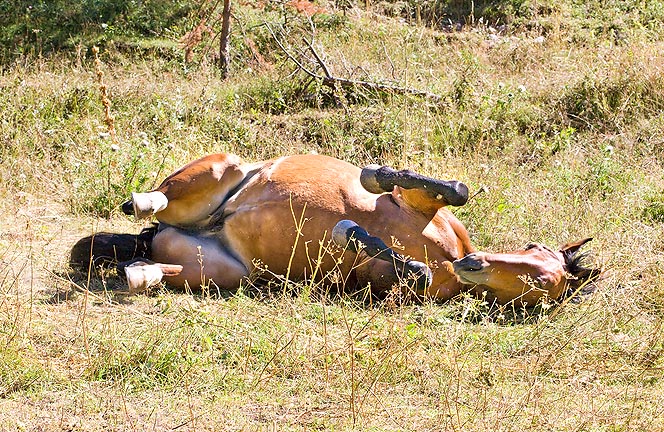
Also horses like playing, possibly rolling on the grass © Giuseppe Mazza
The Arabian purebred has an elegant body, wide front, expressive eyes, long neck, high withers and ample thorax. The limbs are strong and slender, it’s 1,47-1,53 m tall and weighs from 400 to 500 kg. The coat is grey, often dappled, or roan, bay, black.
It is raised in central and southern Arabia, Iran, Iraq, Syria and Israel.
The ponies are horses with a very reduced structure, with height at the withers between 1 and 1,50 m and whose weight at times does not reach the 100 kg.
The polo-pony is specifically trained and utilized for playing polo.
3 – Races “brachymorphic type”. They have very reduced structure, much developed muscles, mild character. These characteristics are utilized for heavy pulling and agricultural works; in the past, they were utilized in the army. To these races belong the Belgian, the Breton, the French Percheron, the Boulonnais, the Shire, the Clydesdale, the Pinzgauer and the Italian Maremmano. The French Percherons have a height at the withers which varies between the 1,56 and the 1,60 m. The head is massive, the front wide, the ears small, the neck robust, the trunk cylindrical and the limbs are particularly resistant and muscled; in the Maremmano race are evident hoofs of big size. Even if these horses proceed with a light and elegant gait, they give, in their overall look, the impression of an exceptional power. The coat is usually dappled grey, but are common also the bay, the sorrel and the roan. The Belgian race is itself subdivided in three types, which are distinguished basing on their dimensions, and is native to Western Europe. The horses belonging to this race have a calm and phlegmatic temperament, the profile is snub, the withers low and broad, the neck short and the rump is high, if compared to the withers. The coat is usually fawn with different tonalities and shades.
The illnesses
Let us now examine the most frequent illnesses which may affect the horses and the equines in general. Some of them are caused by excessive and prolonged efforts, like the “heaves”, consisting in irreversible alterations in the cardiovascular system or the inflammations of the joints of the limbs.
Other illnesses are due to the parasite infestation. The most frequent are the “babesia”, the “horses’ worm”, the “strongyle”, the “horse botfly” and the Trypanosoma equiperdum.
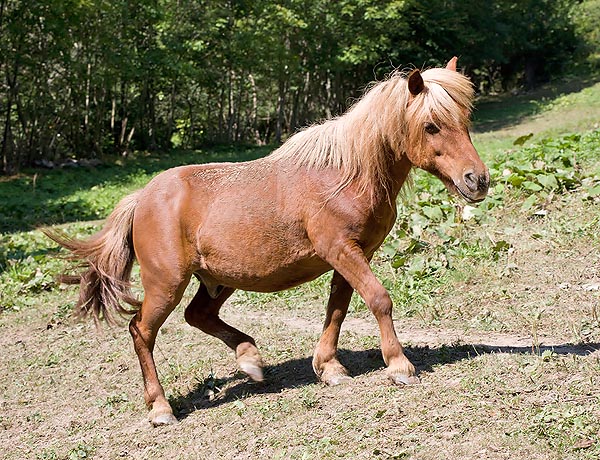
The Ponies are only 100-150 cm tall at the withers © Giuseppe Mazza
The “babesia” is caused by a protozoan (Piroplasma caballi), which is inoculated through a puncture by a tick. This protozoan installs in the red blood cells causing fever, anaemia and jaundice (deposition of haemoglobin on the skin or in the liver, due to the destruction of the red blood cells).
The Ascaris megalocephala, better known as the horses’ worm, does not cause vary serious damages to the host, however, if in high number, it may cause a bowel obstruction.
The strongylosis is produced by nematode worms (i.e. : belonging to the family of the Strongylidae) which localize, when adult, in the bowel causing colic, diarrhoea, anaemia; at the larval stage, these parasites settle in various internal organs, such as the liver, pancreas, etc., producing very serious effects.
The horse botfly is an illness caused by a “dipteran” which lays its eggs between the hairs of the horse. After the hatching, the larvae come out and cause a skin irritation. The animal licks itself seeking relief and, doing so, it swallows the larvae which adhere to the intestinal mucosa by means of mouth hooks which then atrophy, when they penetrate under the mucosa digging, and the cause the horse heavy haemorrhages. The oestrids (myiasitic diptera), have five families: Sarcophagidae, Calliphoridae, Oestridae, Cuterebridae and Gasterophilidae and attack also the birds and the man, not to forget the cattle and sheep oestrid (Hypoderma bovis and Oestrus ovis). The agent of the equine oestrid, the Gasterophilus intestinalis, belongs to the family of the Gasterophilidae, unlike the ovine one, which belongs to the Oestridae.
Last, the Trypanosoma equiperdum, is a form of trypanosomiasis present in all equines, which is transmitted sexually and causes the miscarriage in the pregnant mares as well as damages to the central nervous system (CNS), with motor paralysis, both in males and in mares which have gotten it (for specific details please see text on the Trypanosoma gambiense).
Nowadays, the number of the horses is in general decreasing. This is due to the always more marked utilization, in farming, for the mechanical means which replace the employment of these useful domestic animals which still find their place in the third and fourth world countries, where the scanty agriculture is still effected by means of old techniques. A further utilization, but the sport competitions, is the breeding for butchery: a not much noble end, without any doubt, for these splendid animals.
→ For general information about PERISSODACTYLA please click here.
